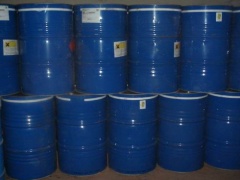Dioctyl Phatalate.jpg
| Infobox on Dioctyl Phatalate.jpg | |
|---|---|
| Example of Dioctyl Phatalate.jpg |  |
| Facts | |
| Origin | - |
| Stowage factor (in m3/t) | - |
| Humidity / moisture | - |
| Ventilation | - |
| Risk factors | See text |
Dioctyl Phatalate.jpg
Contents
Description
Diocthyl Phthalate or Bis(2-ethylhexyl) phthalate (di-2-ethylhexyl phthalate, DEHP; dioctyl phthalate, DOP), is an organic compound with the formula C6H4(C8H17COO)2. This compound is the most common of the class of phthalate plasticizers. It is the diester of phthalic acid and the branched-chain 2-ethylhexanol. This colourless viscous liquid is soluble in oil, but not in water.
DEHP has a low vapour pressure, but the temperatures for processing PVC articles are often high, leading to release of elevated levels, raising concerns about health risks. It can be absorbed from food and water. Higher levels have been found in milk and cheese. It can also leach into a liquid that comes in contact with the plastic; it extracts faster into nonpolar solvents (e.g. oils and fats in foods packed in PVC). Food and Drug Administration (FDA) therefore permits use of DEHP-containing packaging only for foods that primarily contain water. In soil, DEHP contamination moves very slowly because of its low solubility in water. Therefore, leaching from disposed plastics in landfills is generally slow. The US EPA limits for DEHP in drinking water is 6 ppb. The U.S. agency OSHA's limit for occupational exposure is 5 mg/m3 of air.
Application
Due to its suitable properties and the low cost, DEHP is widely used as a plasticizer in manufacturing of articles made of PVC. Plastics may contain 1% to 40% of DEHP. It is also used as a hydraulic fluid and as a dielectric fluid in capacitors. DEHP also finds use as a solvent in glowsticks.
Shipment / Storage
Keep containers tightly closed. Store in cool, dry location. Keep from freezing.
Oxidizing materials. Any use of this product in elevated temperature processes should be evaluated to establish and maintain safe operating procedures.
| Melting point | -50°C |
| Boiling point | 384°C |
| Specific gravity | 0,9861 |
Risk factors
May be combustible at high temperatures. Environmentally hazardous substance.
For overseas carriage aspects of Chemicals, the readers are recommended to acquire or have access to a good chemical dictionary, and a copy of the International Maritime Dangerous Goods (IMDG) Code, issued by the International Maritime Organisation. Also consult the applicable MSDS sheet.
See also: http://www.chemicalland21.com/industrialchem/plasticizer/DOP.htm











